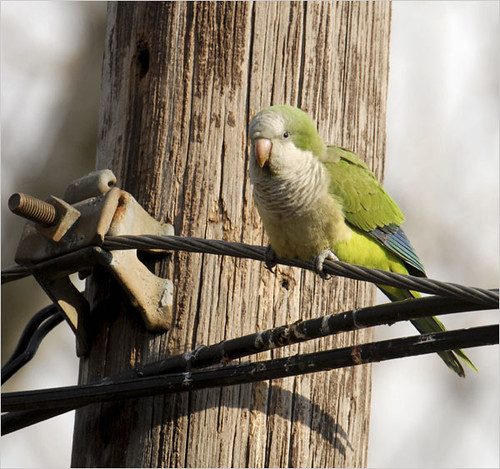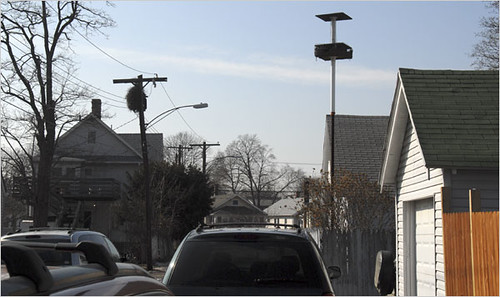In This Springtime Battle, the Parakeets Appear to Be Winning
 Sunday, March 22, 2009 at 10:17
Sunday, March 22, 2009 at 10:17  Monk parakeet by Alan Zale for The New York Times IT’S spring, and monk parakeets, the small green birds from South America that have proliferated in Connecticut and other parts of the region, are building their huge nests in utility poles and lighting fixtures here — rebuilding, really, after their nests were torn down by utility workers last fall.
Monk parakeet by Alan Zale for The New York Times IT’S spring, and monk parakeets, the small green birds from South America that have proliferated in Connecticut and other parts of the region, are building their huge nests in utility poles and lighting fixtures here — rebuilding, really, after their nests were torn down by utility workers last fall.
United Illuminating, the utility company, is in the midst of its twice-yearly campaign to remove the bulky nests, which they say can cause power failures and electrical fires.
West Haven is not the only battleground in the efforts to keep the birds out of utility poles and other lighting fixtures, a struggle that has pitted the utility companies and municipal agencies against animal-rights activists since the parakeets found a home in towns in the region beginning in the 1970s. In a recent survey, United Illuminating said it had counted 75 monk nests in seven towns on its electrical poles.
In Stamford, the parks department has worked with animal advocates to build platforms as an alternative nesting site near lights in Cummings Park, where the parakeets have built nests. So far, just a few birds have moved to this alternative housing.
The exotic birds would not be so noticeable among the area’s many species of winged creatures were it not for the size of their nests and where they choose to build them. A typical nest provides a home for about 20 pairs of birds and can weigh as much as 440 pounds, officials said. The material from one nest, mostly twigs, can fill the back of a city pickup truck, they said.
 LOOK HERE In West Haven, a homeowner built a platform, right, to try to attract monk parakeets away from the nest they built on a utility pole, left. By Thomas McDonald for The New York Times
LOOK HERE In West Haven, a homeowner built a platform, right, to try to attract monk parakeets away from the nest they built on a utility pole, left. By Thomas McDonald for The New York Times
Attempts to get the birds off power and lighting fixtures have proved difficult. In 2005, United Illuminating captured a number of birds and then turned them over to United States Department of Agriculture officials, who euthanized them. That caused an outcry among animal-rights advocates. Friends of Animals, a Darien-based group, sued United Illuminating to stop further killing of the birds. The suit was dismissed by a Superior Court judge last summer, but the group has filed an appeal.
Al Carbone, a spokesman for United Illuminating, said the campaign to remove the nests, which costs the utility company between $60,000 and $70,000 annually, has not proved effective. The birds like the warmth of the transformers, Mr. Carbone said, and keep returning even when their nests have been torn down once. On a recent tour of parts of West Haven, Mr. Carbone pointed out several of the nests, some the size of basketball hoops, along shoreline utility poles.
Company workers remove the nests in late March and early April, before the mating season begins, and again in the fall, typically October, well after any eggs are hatched, officials said.
Kathleen Hickey, 60, of Bungalow Lane in West Haven, said she was concerned about the birds causing power failures because her mother, who lives with her, relied on oxygen machines. There are many other elderly residents on the street as well, she said.
“I don’t want the birds killed. We love animals. Maybe they can be moved to a wildlife place,” she said. “When you sit outside in the summer, they do get annoying.”
Mr. Carbone said the utility company had no plans to resume having the birds euthanized, but it is looking at other methods to keep them from building nests on the poles.
In Stamford, the nests prevented parks workers from being able to change light bulbs or do any maintenance on the lighting fixtures. One nest even caught fire, officials said.
“We were told if we put man-made bunkers up and left the sticks for their nests by the bunkers they would relocate in a matter of days, but they actually didn’t,” said Kevin Murray, parks manager. “Now they are in the trees.” The birds have also started nesting in lighting fixtures at the athletic stadium at Stamford High School.
Jenny Dickson, a wildlife biologist with the state Department of Environmental Protection, said the parakeets can be very persistent.
“Monk parakeets are one of the toughest birds to discourage. They can be tenacious,” Ms. Dickson said. “It is not as simple as removing the nests and then they will go nest in trees. Part of what attracts them to utility structures is the cross beams.”
Priscilla Feral, president of the group Friends of Animals, said she’d like to see more legal efforts to protect the birds from being killed.
“I’m really unhappy with the crass attitude that every other animal has to make room for us,” Ms. Feral said. “We have room for these birds. We can cooperate to discourage them from nesting on poles and still have a place in this environment for them.”
This article has been revised to reflect the following correction:
Correction: March 29, 2009
An article last Sunday about efforts to remove monk parakeet nests from utility poles and other lighting fixtures throughout Connecticut, misstated the number of towns where the nests were found in a survey by the utility company United Illuminating. The survey found the nests in 7 towns, not 17.
 Myiopsitta monachus - Monk Parakeet | in
Myiopsitta monachus - Monk Parakeet | in  Conflict,
Conflict,  Urban parrots
Urban parrots 
